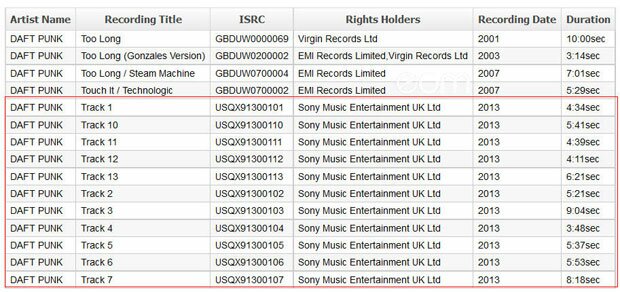
Daft Punk and the State of Dance Music in America
If you paid any attention to South by Southwest (SXSW) in Austin, Texas this past week, you probably got wind of the rumors that music gods Daft Punk were to perform for the first time in years at the festival. Fliers around the city that had the duo’s newly released imagery, text that stated “DISCO IS ALIVE” and the teasing date “3.15” kept fans wondering whether the long-awaited return of the French robot-happy beat makers had finally arrived. As of now, no such return has been reported. However, we will, likely, be hearing new Daft Punk music by the time exams are rolling around.

Via: dancingastronaut.com
According to Nile Rodgers, former member of disco group Chic and producer of artists such as David Bowie and Madonna, the group will be releasing the album by the time he sets foot back in Japan. Speculation of when the album will be released, exactly, has been ongoing ever since Rodgers revealed he was involved with the project last August. It seems fitting, too much so to be coincidental, that the week before the first weekend of Ultra Music Festival, the biggest annual event in dance music, these Daft Punk rumors have began to resurface.
Daft Punk is perhaps the most mysterious musical act in memory since Led Zeppelin. Other than a brief stint of appearing in commercials around the time their landmark album Discovery was released, Thomas Bangalter and Guy-Manuel de Homem-Christo, the group’s two members, have done everything in their power to keep themselves out of the spotlight. The robot imagery so closely associated to the duo came about as a ploy to hide their faces from the public, allowing the music and art to speak for itself. By creating an image to distribute their music and art through, they maintained power over how the public perceived Daft Punk. This has also lead to them maintaining power over their music, not ever being pushed to please the mainstream and cater to the radio or pop charts. In essence, Daft Punk has become exactly what every musician or artist should aspire to be.

Via: theverge.com
So why is Daft Punk so important if they do such a phenomenal job of staying out of mainstream pop culture? Even as an enigma, they have managed to be as influential as the aforementioned Zeppelin or even Elvis Presley. Though the group has only released three albums (I don’t count the score they did for Disney’s Tron: Legacy as an album), their influence has been felt in almost every genre of music in the past decade. From Kanye West, to LCD Soundsytem, to 2007’s pride of French electronic music, Justice, to the most recent French electronic prodigy Madeon, Daft Punk’s music has transcended genre, and music, to become one of the largest driving forces in art and culture. While contemporaries such as Chemical Brothers, Fatboy Slim and Prodigy, still maintain a significant presence in the electronic music, only Daft Punk demands the kind of universal reverence given to the likes of The Beatles.
Back to how this is all coming together, there is no question that the genre of music that has dominated culture for the past 3-5 years has been electronic dance music (EDM, a term I’m not thrilled to use but works as a catch-all for genres of electronic music that have recently become popular in the United States). Ultra Music Festival is the biggest EDM event of the year as a part of Winter Music Conference, a time when electronic artists flock to Miami to learn about the latest music technology, exchange ideas and do some serious partying. This has been going on for years, as Miami has long been one of the hottest clubbing destinations in the world and a place where dance music was able to thrive in America before this national EDM craze we’re experiencing now. With the exponential growth of festivals like Ultra and the newly-found status of rockstar DJs such as Skrillex, David Guetta, Avicii and Swedish House Mafia who sell out arenas like Bon Jovi in the 80s, dance music is finally experiencing uniquely American cultural phenomena that have affected every other genre of music that has become popular in the mainstream. These phenomena can be summed up into the oversaturation of a genre based on its marketability.
Like grunge music in the 90s and hip-hop in the late 80s and the years around the turn of the millennium, EDM is being exploited and transformed into a ubiquitous part of our culture. Commercials on TV constantly use dubstep and house music as a selling tool to exhibit how companies are innovative and hip. It’s infiltrated the music of pop artists such as Flo Rida and Pitbull, who shamelessly release singles with shit lyrics put over popular house tunes. In the most definitive example to me of just how far the craze has gone, a buddy of mine who swears by Dave Matthews Band and Phish drunkenly stumbled into my room last year with a number of girls and demanded that I put on “Levels.” I’ve got no problem with people expanding their taste in music. Hell, I love Dave Matthews and Phish as much as I love artists like Tiesto. In the context of the drunken demand, this kid was only interested in hearing the song because he knew it to be popular and associated it with excessive partying. When the people demanding something are the people with the shallowest interests in it, the peak has arrived and the hangover is about to set in.
It is my belief that if we haven’t hit the peak of the dance music craze in America, we will soon. As a passionate fan of the music, I am more than OK with this happening. The oversaturation of the market has translated into the oversaturation of sound. The common complaint from those who are not fans, that all EDM sounds the same, is growing more and more true. There is a significant lack of experimentation in sound from the EDM that has gotten popular over the past couple of years. Producers of the music crank out singles like Motown in the 60s, hoping for something to stick. Unlike those legendary Motown tunes (The Temptations, The Supremes, The Four Tops, etc), the mass production of EDM lacks heart and soul. That is why “My Girl” is a classic and “Molly” by Cedric Gervais will be forgotten. By the time Ultra Music Festival rolls around next year, the feelings of an EDM backlash will already be felt in American culture.
How big that backlash gets is dependent on a couple of things.
If trends are to continue how they are, the dance music scene will split into definitive mainstream and underground movements. The mainstream will cater to the masses for another year or two, however long it takes before another genre of music rises up and takes its place. Many people who were die-hard fans of EDM in their college years will completely lose interest in the music. This, in many ways, has already started to happen. I have plenty of friends who attended every EDM concert they could for a period of 6 months to a year and have no interest in the music at all, anymore. Eventually, the entire mainstream fan base will be filled with these “casual fans” and the end of will only be a matter of time. The underground movement will be different.
Rather than cater to the masses, the music coming from the would-be underground movement will cater to nobody, at least for a period of time. This would be a time of experimentation and revolution within dance music, allowing artists to pursue their ideas to an unfathomable degree. Realistically, a lot of the early music from this movement will be hard to swallow, especially for “casual fans.” However, after time, the music will regain popularity in mainstream culture but it won’t become the insane cultural phenomenon it was the past 3-5 years. It will reach a point of beautiful equilibrium in which the encouragement of artists to experiment will result in music that becomes popular not because of the hype of a movement, but because the music is too damn good to deny.
One trend that has recently reached the American dance music movement could potentially lessen this initial divide. Artist-driven record labels are becoming more and more prevalent in the scene and help foster listenable music while keeping its integrity intact. Labels such as Skrillex’s OWSLA, A-Trak’s Fools Gold Records and Diplo’s Mad Decent Records are all examples of artists that are relevant to the mainstream movement supporting and producing music outside the realm of the supersaturated. Controversy king deadmau5 established a label years ago, mau5trap, so that he, as an artist, could have a say in the music that was being produced for the public. By keeping the artist’s ideas in mind, the music that gets produced is inherently unique because each artist has an individual and distinctive sound. In this way, the music that those artists make becomes more powerful because the sound isn’t able to be confused for another’s work. So far, these artist-driven labels have been a major success in terms of producing incredible music that fans can latch their ears onto. If they continue to be a success, the EDM craze in America will not as much divide as it will trim the fat until it becomes a lean, mean, music-making machine.
So how does Daft Punk factor into all of this? They are the best example of artist-driven music that has a stake in mainstream culture. The fact that they are releasing an album right around the time the EDM craze is peaking is no coincidence. The time has come for some sort of revolution in the music. The album they release within the next months will have a massive effect on the dance music scene as well as on music in general. It should be, and likely will be, the benchmark of what can be accomplished in electronic music, a statement to the banal and trite artists of the day on what is possible. The album will either incite artists across the board to experiment with the infinite possibilities technology offers them or it will incite a handful to begin that underground movement. Either way, it should be the catalyst for some of the most exciting music people have ever dreamt of. While the chaos that is the mainstream EDM movement is nearing its end, the best that electronic music has to offer is yet to come.
Update: According to Mixmag, the new Daft Punk album will be 13 tracks long.

Via: mixmag.net
Image courtesy of: Global Dance Electronic












Pingback: UMF Recap: Expect The Ultra-unexpected | Gainesville Scene
Pingback: Got Lucky: Daft Punk Single Leaked | Gainesville Scene